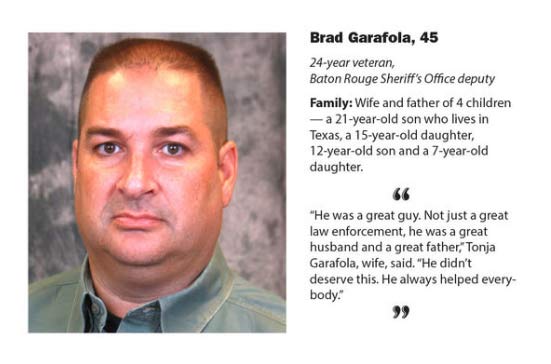One was once injured trying to save a toddler from a burning building. Another helped chase down a serial rapist now serving a 50-year prison sentence. The third was a rookie cop but served as a crew chief on a helicopter crew during multiple U.S. Army tours in Iraq.
Roco wishes to honor these three courageous officers, who lost their lives in the tragic police shooting of July 16, 2016, in our hometown of Baton Rouge, LA. Our thoughts and prayers are with their families, the other officers who are recovering, and with those in law enforcement who continue to serve our community on a daily basis. 

 Support for the Families
Support for the Families
The East Baton Rouge First Responders Fund raises money for law enforcement officers and first responders who may be injured or killed in the line of duty and for their families. It is designed to help survivors who will require much time and assistance to recover from their wounds and the families of those who have fallen in the line of duty. The fund is overseen by EBR Sheriff Sid Gautreaux, Baton Rouge Police Chief Carl Dabadie Jr., Baton Rouge Fire Chief Ed Smith and Louisiana State Police Major Mike Noel. Contributions are tax deductible.
Source: The Advocate, July 18, 2016

 Support for the Families
Support for the Families OSHA’s
OSHA’s  This helpful new guide provides information for evaluating your rescue team or prospective rescue service based on the requirements of OSHA 1910.146 and 1926 Subpart AA. It includes a Rescue Team Evaluation Checklist from Appendix F and illustrates Confined Space Types 1-6, which is based on criteria from OSHA 1910.146. Roco’s method of categorizing confined spaces by various types can be useful in establishing practice requirements for your rescue service.
This helpful new guide provides information for evaluating your rescue team or prospective rescue service based on the requirements of OSHA 1910.146 and 1926 Subpart AA. It includes a Rescue Team Evaluation Checklist from Appendix F and illustrates Confined Space Types 1-6, which is based on criteria from OSHA 1910.146. Roco’s method of categorizing confined spaces by various types can be useful in establishing practice requirements for your rescue service. According to latest reports, the U.S. workplace fatality rate increased in 2014 with the highest death rate in seven years. That is the first time it has done so since 2010, according to
According to latest reports, the U.S. workplace fatality rate increased in 2014 with the highest death rate in seven years. That is the first time it has done so since 2010, according to  One minute a worker was working in the 8-foot trench below ground. The next, he was being buried in it. His co-workers came to his rescue, digging him out with their bare hands. Moments after they pulled the injured man to safety, the unprotected trench collapsed again. His injuries were serious and led to his hospitalization.
One minute a worker was working in the 8-foot trench below ground. The next, he was being buried in it. His co-workers came to his rescue, digging him out with their bare hands. Moments after they pulled the injured man to safety, the unprotected trench collapsed again. His injuries were serious and led to his hospitalization.


